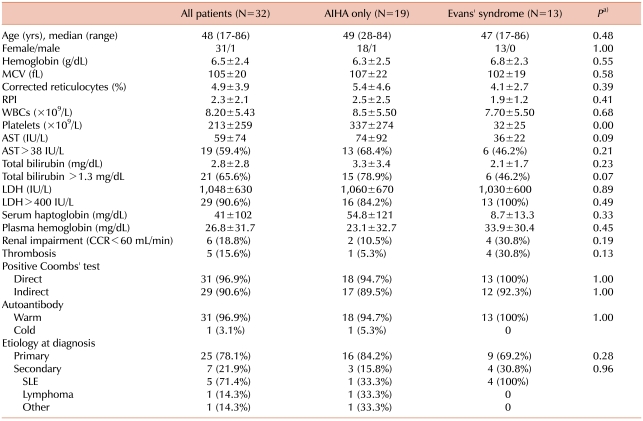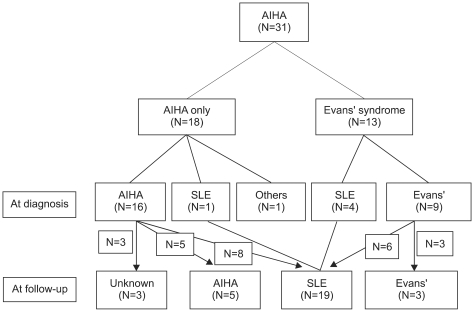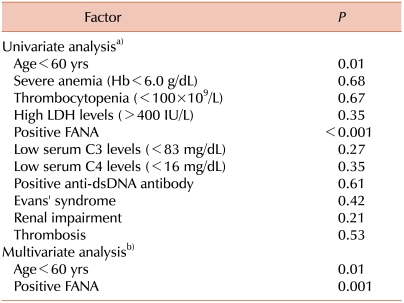1. Packman CH. Hemolytic anemia due to warm autoantibodies: new and traditional approaches to treatment. Clin Adv Hematol Oncol. 2008; 6:739–741. PMID:
18997664.
2. Klein NP, Ray P, Carpenter D, et al. Rates of autoimmune diseases in Kaiser Permanente for use in vaccine adverse event safety studies. Vaccine. 2010; 28:1062–1068. PMID:
19896453.

3. Eaton WW, Rose NR, Kalaydjian A, Pedersen MG, Mortensen PB. Epidemiology of autoimmune diseases in Denmark. J Autoimmun. 2007; 29:1–9. PMID:
17582741.

4. Budman DR, Steinberg AD. Hematologic aspects of systemic lupus erythematosus. Current concepts. Ann Intern Med. 1977; 86:220–229. PMID:
835948.
5. Rosenthal DS, Sack B. Autoimmune hemolytic anemia in scleroderma. JAMA. 1971; 216:2011–2012. PMID:
5108636.

6. Giannadaki E, Potamianos S, Roussomoustakaki M, Kyriakou D, Fragkiadakis N, Manousos ON. Autoimmune hemolytic anemia and positive Coombs test associated with ulcerative colitis. Am J Gastroenterol. 1997; 92:1872–1874. PMID:
9382055.
7. Ellis LD, Westerman MP. Autoimmune hemolytic anemia and cancer. JAMA. 1965; 193:962–964. PMID:
14343919.

8. Saif MW. HIV-associated autoimmune hemolytic anemia: an update. AIDS Patient Care STDS. 2001; 15:217–224. PMID:
11359664.

9. Khan FY, A yassin M. Mycoplasma pneumoniae associated with severe autoimmune hemolytic anemia: case report and literature review. Braz J Infect Dis. 2009; 13:77–79. PMID:
19578637.

10. Territo MC, Peters RW, Tanaka KR. Autoimmune hemolytic anemia due to levodopa therapy. JAMA. 1973; 226:1347–1348. PMID:
4202390.

11. Shen Y. Autoimmune hemolytic anemia associated with a formulation of traditional Chinese medicines. Am J Health Syst Pharm. 2009; 66:1701–1703. PMID:
19767374.

12. Valent P, Lechner K. Diagnosis and treatment of autoimmune haemolytic anaemias in adults: a clinical review. Wien Klin Wochenschr. 2008; 120:136–151. PMID:
18365153.

13. King KE, Ness PM. Treatment of autoimmune hemolytic anemia. Semin Hematol. 2005; 42:131–136. PMID:
16041662.

14. Barros MM, Blajchman MA, Bordin JO. Warm autoimmune hemolytic anemia: recent progress in understanding the immunobiology and treatment. Transfus Med Rev. 2010; 24:195–210. PMID:
20656187.
15. Lechner K, Jäger U. How I treat autoimmune hemolytic anemias in adults. Blood. 2010; 116:1831–1838. PMID:
20548093.

16. Yi Y, Zhang GS, Gong FJ, Yang JJ. Multiple myeloma complicated by Evans syndrome. Intern Med J. 2009; 39:421–422. PMID:
19580625.

17. Hara A, Wada T, Kitajima S, et al. Combined pure red cell aplasia and autoimmune hemolytic anemia in systemic lupus erythematosus with anti-erythropoietin autoantibodies. Am J Hematol. 2008; 83:750–752. PMID:
18626921.

18. Lim YA, Kim MK, Hyun BH. Autoimmune hemolytic anemia predominantly associated with IgA anti-E and anti-c. J Korean Med Sci. 2002; 17:708–711. PMID:
12378029.

19. Naithani R, Agrawal N, Mahapatra M, Pati H, Kumar R, Choudhary VP. Autoimmune hemolytic anemia in India: clinico-hematological spectrum of 79 cases. Hematology. 2006; 11:73–76. PMID:
16522555.

20. Karasawa M. Autoimmune hemolytic anemia. Nippon Rinsho. 2008; 66:520–523. PMID:
18326320.
21. Hochberg MC. Updating the American College of Rheumatology revised criteria for the classification of systemic lupus erythematosus. Arthritis Rheum. 1997; 40:1725. PMID:
9324032.

22. Michel M, Chanet V, Dechartres A, et al. The spectrum of Evans syndrome in adults: new insight into the disease based on the analysis of 68 cases. Blood. 2009; 114:3167–3172. PMID:
19638626.

23. Genty I, Michel M, Hermine O, Schaeffer A, Godeau B, Rochant H. Characteristics of autoimmune hemolytic anemia in adults: retrospective analysis of 83 cases. Rev Med Interne. 2002; 23:901–909. PMID:
12481390.
24. Zhang Y, Chu Y, Shao Z. The clinical implications of IgG subclass in 84 patients with autoimmune hemolytic anemia. Zhonghua Xue Ye Xue Za Zhi. 1999; 20:524–526. PMID:
11721398.
25. Zent CS, Ding W, Reinalda MS, et al. Autoimmune cytopenia in chronic lymphocytic leukemia/small lymphocytic lymphoma: changes in clinical presentation and prognosis. Leuk Lymphoma. 2009; 50:1261–1268. PMID:
19811329.

26. Evans RS, Takahashi K, Duane RT, Payne R, Liu C. Primary thrombocytopenic purpura and acquired hemolytic anemia: evidence for a common etiology. AMA Arch Intern Med. 1951; 87:48–65. PMID:
14782741.
27. Norton A, Roberts I. Management of Evans syndrome. Br J Haematol. 2006; 132:125–137. PMID:
16398647.

28. Silverstein MN, Heck FJ. Acquired hemolytic anemia and associated thrombocytopenic purpura: with special reference to Evans' syndrome. Proc Staff Meet Mayo Clin. 1962; 37:122–128. PMID:
13912960.
29. Giannouli S, Voulgarelis M, Ziakas PD, Tzioufas AG. Anaemia in systemic lupus erythematosus: from pathophysiology to clinical assessment. Ann Rheum Dis. 2006; 65:144–148. PMID:
16079164.

30. Jeffries M, Hamadeh F, Aberle T, et al. Haemolytic anaemia in a multi-ethnic cohort of lupus patients: a clinical and serological perspective. Lupus. 2008; 17:739–743. PMID:
18625652.
31. Thumboo J, Fong KY, Chng HH, et al. The effects of ethnicity on disease patterns in 472 Orientals with systemic lupus erythematosus. J Rheumatol. 1998; 25:1299–1304. PMID:
9676760.
32. Lee SY, Chi HS. Hematologic findings in systemic lupus erythematosus. Korean J Clin Pathol. 1998; 18:14–19.





 PDF
PDF ePub
ePub Citation
Citation Print
Print








 XML Download
XML Download